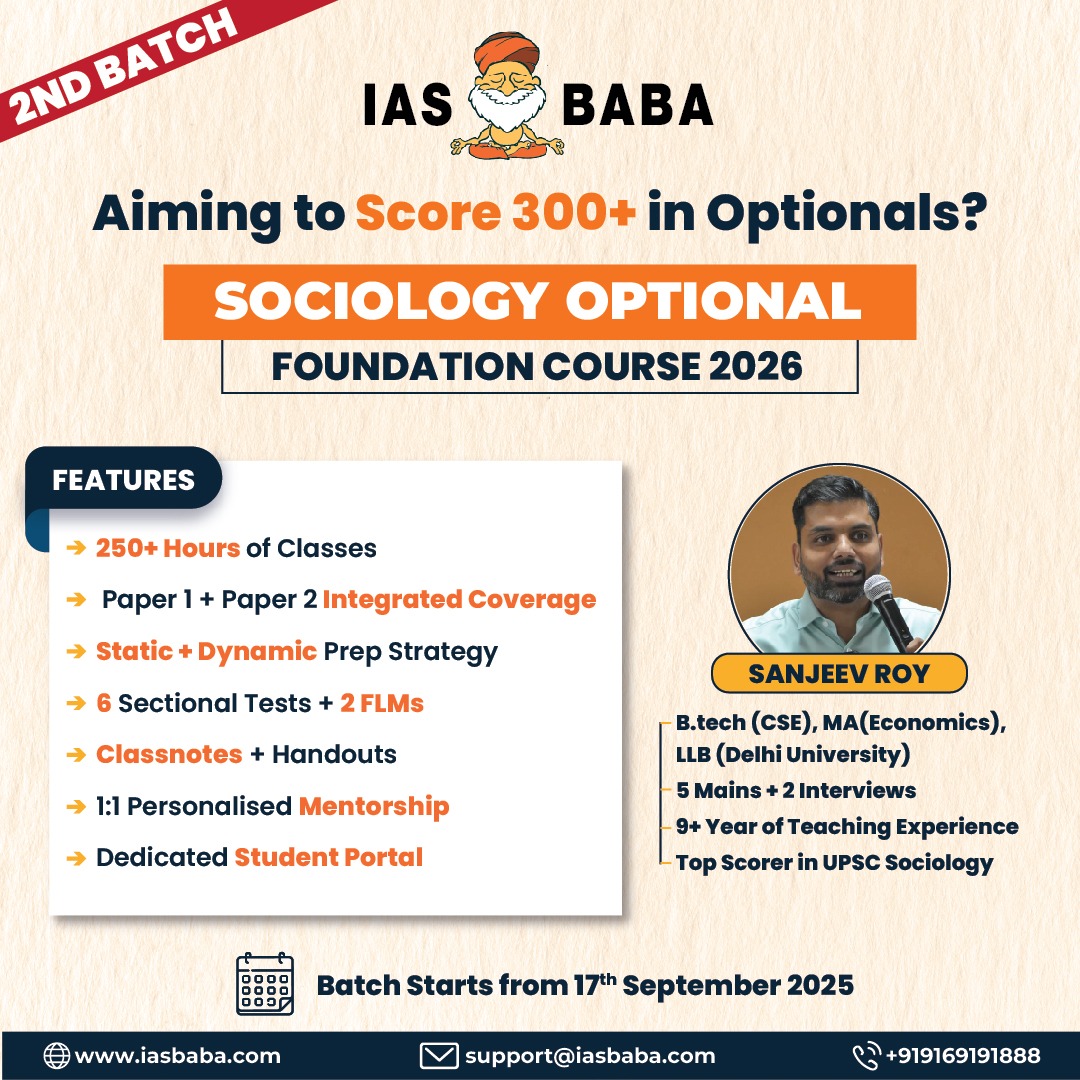IASbaba's Daily Current Affairs Analysis
Archives
(PRELIMS Focus)
Category: POLITY
Context: Climate activist Sonam Wangchuk was recently detained under the National Security Act (NSA), reigniting debate over its scope and misuse.
- About NSA (1980): Allows preventive detention to safeguard defence, foreign relations, security of India, public order, or essential supplies.
- Powers: Centre, states, District Magistrates, and Police Commissioners can authorize detention.
- Nature: Not punitive but preventive — meant to stop individuals before they act.
- Safeguards:
- Grounds of detention must be communicated within 5–15 days.
- Review by Advisory Board of High Court judges within 3 weeks.
- Detention can extend up to 12 months.
- No legal representation before Advisory Board; government can withhold facts citing “public interest.”
- Past use: Invoked against separatists, gangsters, and protesters.
- Controversies:
- Criticized for misuse against dissenters and activists.
- High-profile cases: Dr. Kafeel Khan (2020), Chandrashekhar Azad (2017), Amritpal Singh (2023).
- Used during anti-CAA protests and in states like UP and MP against cow slaughter and habitual criminals.
- Criticism: Civil liberties groups see it as a draconian law often misused by governments to silence opposition rather than protect security.
Learning Corner:
National Security Act (NSA), 1980
- The NSA, 1980 is a preventive detention law that empowers the Central and State governments to detain individuals to prevent them from acting in any manner prejudicial to the defence of India, relations with foreign powers, national security, public order, or maintenance of essential supplies and services.
- It continues India’s long history of preventive detention laws, tracing back to the colonial era and the Maintenance of Internal Security Act (MISA).
Key Provisions
- Authority to Detain:
- The Central or State government can issue detention orders.
- District Magistrates and Police Commissioners can also exercise this power when authorised.
- Grounds of Detention:
- Defence of India, security of the state, public order, and maintenance of essential supplies.
- Duration of Detention:
- A person can be detained up to 12 months, though orders can be revoked earlier.
- Communication of Grounds:
- Detainee must be informed of the grounds of detention within 5–15 days.
- Review Mechanism:
- An Advisory Board of High Court judges reviews the detention within 3 weeks.
- If the Board finds “no sufficient cause,” the detainee must be released.
- Safeguards and Limitations:
- No legal representation before the Advisory Board.
- Government can withhold facts citing “public interest.”
- Preventive, not punitive — meant to stop anticipated threats.
Source: THE INDIAN EXPRESS
Category: INTERNATIONAL
Context : OPEC+ is planning another oil output hike in November 2025 amid rising global oil prices and market pressures.
- Decision timeline: OPEC+ countries will meet online on October 5 to decide on November production levels.
- Expected hike: At least 1,37,000 barrels per day increase likely, equal to October’s hike.
- Background: OPEC+ had reversed April’s output cuts and already boosted production by 2.5 million bpd between April–September.
- Market impact: Oil prices have risen above $70 per barrel due to tight supply and geopolitical tensions, including Ukraine–Russia conflict.
- Group output cuts: Current reduction stands at 5.85 million bpd (voluntary 2.2m, 1.65m by 8 members, and 2m by whole group).
- Further scope: Additional increases under discussion to stabilize market supply.
- UAE approval: Separate 300,000 bpd boost approved for UAE between April–September.
- Long-term plan: The third group-wide layer of cuts (1.65m bpd) is scheduled to last till end of 2026.
Learning Corner:
OPEC+ (Organization of the Petroleum Exporting Countries Plus)
- Composition: OPEC (13 member states, mostly Middle Eastern and African oil producers) + 10 major non-OPEC oil exporters, most notably Russia, Kazakhstan, Mexico, etc.
- Origin: Formed in 2016 when OPEC partnered with non-OPEC countries to stabilize oil markets through coordinated output decisions.
- Objective: To manage global oil supply, stabilize prices, and safeguard revenues for oil-producing countries.
- Functioning:
- Sets collective production quotas.
- Adjusts supply to balance market demand and global price fluctuations.
- Key influence on international energy markets and global inflation trends.
- Recent relevance (2025):
- Reversed earlier cuts (April 2025) and increased output by 2.5 million barrels/day till September.
- Plans another hike of 1,37,000 barrels/day in November amid rising oil prices and geopolitical tensions (Ukraine–Russia conflict, energy security concerns).
- Long-term strategy includes gradual easing of supply cuts lasting until end-2026.
Source: THE INDIAN EXPRESS
Category: POLITY
Context: India has released draft Corporate Average Fuel Efficiency (CAFE-3) rules proposing new vehicle emission norms, with relief for small cars and incentives for EVs..
- What’s new: Draft CAFE-3 norms issued by the Bureau of Energy Efficiency (BEE) for public consultation, covering all M1 category passenger cars (max 9 seats, 3,500 kg).
- Efficiency formula: Based on fleet weight with stricter targets over FY28–FY32; lighter vehicles get more relaxed targets.
- Relief for small cars: Special exemptions for models ≤1200cc engine, ≤4000mm length, and ≤900kg unladen weight → eligible for CO₂ reduction credits.
- Emissions pooling: Allows multiple carmakers to pool emissions targets, reducing compliance costs.
- EV incentives:
- Each EV sale counts three times in compliance calculations.
- Hybrid EVs, plug-in hybrids, and strong hybrids get multipliers.
- EVs under 3,500 kg get special weight-based relaxation.
- Carbon Neutrality Factor (CNF): Additional relaxation based on fuel types (ethanol, CNG, biogas, hybrids).
- Penalties: Non-compliance attracts penalties under the Energy Conservation Act, 2001.
- Current norms: CAFE-2 (from FY22–23) required fleet CO₂ emissions ≤113 g/km; penalties apply for exceeding limits.
- EV charging infra: Govt plans ~72,300 stations under PM E-Drive, with subsidy support for installation across cities.
Learning Corner:
Corporate Average Fuel Efficiency (CAFE) Norms
- Definition:
CAFE norms are fuel efficiency and emission standards that automobile manufacturers must follow for their fleet, aimed at reducing fuel consumption and lowering carbon dioxide (CO₂) emissions. - Origin in India:
Introduced by the Bureau of Energy Efficiency (BEE) under the Energy Conservation Act, 2001.- CAFE–1: Notified in 2011, effective from 2017.
- CAFE–2: Implemented from 2022–23, targeting 113 g/km CO₂ fleet average.
- CAFE–3 (Draft, 2025): Proposes stricter norms for FY28–FY32 with new incentives for small cars and EVs.
- Key Features:
- Applies to all M1 category cars (passenger vehicles ≤9 seats, ≤3,500 kg).
- Uses a formula based on average fleet weight; heavier cars allowed slightly higher emissions than lighter cars.
- Manufacturers must ensure that their entire fleet average meets prescribed targets.
- Penalties: Non-compliance attracts fines under the Energy Conservation Act, 2001.
- Special Provisions in Draft CAFE-3:
- Relief for small cars (≤1200 cc engine, ≤4000 mm length, ≤900 kg weight).
- Pooling option: Carmakers can pool emissions with other firms.
- EV incentives:
- Each EV sale counts as 3 vehicles in compliance calculation.
- Hybrid & CNG cars get partial credits.
- Carbon Neutrality Factor (CNF): Additional credits for ethanol, CNG, and biogas fuel use.
- Objective:
To align India with global climate commitments, reduce oil dependence, encourage electric mobility, and cut vehicular CO₂ emissions.
Source: THE INDIAN EXPRESS
Category: CULTURE
Context PM Modi, in Mann ki Baat, praised the RSS on its centenary journey and highlighted the government’s push for Chhath Puja’s inclusion in UNESCO’s intangible cultural heritage list.
- On RSS:
- Praised founder K.B. Hedgewar for fighting against “intellectual slavery.”
- Appreciated RSS’s century-long role in national service, sacrifice, and discipline.
- Emphasized “nation-first” spirit in every RSS worker’s contribution.
- On Chhath Puja:
- Govt making efforts for UNESCO Intangible Cultural Heritage recognition.
- Said recognition would help spread Chhath’s cultural and spiritual values worldwide.
- Other mentions:
- Recalled Bhupen Hazarika’s birth centenary
- Expressed condolences on the passing of singer Zubeen Garg.
- Significance:
- Strengthening cultural pride, heritage recognition, and linking traditions with India’s global image.
Learning Corner:
Chhath Puja
- Nature of Festival: An ancient Hindu Vedic festival dedicated to the Sun God (Surya) and Chhathi Maiya (Usha, the wife of the Sun God).
- Observed in: Primarily in Bihar, Jharkhand, Eastern Uttar Pradesh, and the Mithila region of Nepal; also celebrated by diaspora communities.
- Timing: Held twice a year — most prominently after Diwali (October–November, Kartika month), known as Chhath Mahaparva.
- Rituals:
- Lasts four days with strict rituals including fasting, holy bathing, and offering Arghya (water and prayers) to the rising and setting Sun.
- Devotees observe Nirjala Vrat (fast without water) as part of the worship.
- Celebrated on riverbanks and water bodies, symbolizing purity.
- Cultural significance:
- Emphasizes gratitude to nature, ecological balance, and solar energy.
- Promotes social harmony and collective participation.
- Global recognition: India is making efforts to get Chhath Puja inscribed in UNESCO’s Intangible Cultural Heritage list.
India & UNESCO Intangible Cultural Heritage (ICH)
- Convention: UNESCO’s Convention for the Safeguarding of the Intangible Cultural Heritage (2003) aims to preserve cultural practices, traditions, and knowledge systems.
- India’s Status: India ratified in 2005; as of 2025, India has 15 elements inscribed on UNESCO’s ICH Representative List.
India’s ICH Elements (as of 2025):
- Kutiyattam, Sanskrit theatre – Kerala – 2008
- Tradition of Vedic Chanting – Across India – 2008
- Ramlila, the traditional performance of the Ramayana – North India – 2008
- Ramman, religious festival and ritual theatre – Uttarakhand – 2009
- Chhau dance – Jharkhand, West Bengal, Odisha – 2010
- Kalbelia folk songs and dances – Rajasthan – 2010
- Mudiyettu, ritual theatre and dance drama – Kerala – 2010
- Buddhist chanting of Ladakh – Ladakh – 2012
- Sankirtana, ritual singing, drumming and dancing – Manipur – 2013
- Traditional brass and copper craft of utensil making among the Thatheras of Jandiala Guru – Punjab – 2014
- Nowruz – Celebrated in India by Parsi community (shared with other countries) – 2016
- Yoga – Across India – 2016
- Kumbh Mela – Haridwar, Prayagraj, Ujjain, Nashik – 2017
- Durga Puja in Kolkata – West Bengal – 2021
- Garba of Gujarat – Gujarat – 2023
Source: THE INDIAN EXPRESS
Category: SCIENCE AND TECHNOLOGY
Context India’s first space-based observatory AstroSat has completed 10 years since its launch in 2015, continuing to provide valuable astronomical data..
- Launch: AstroSat launched on September 28, 2015, by PSLV-C30 (XL) rocket from Satish Dhawan Space Centre, Sriharikota.
- Mission life: Originally designed for 5 years, but continues to function effectively after a decade.
- Significance: India’s first dedicated multi-wavelength space observatory, comparable to NASA’s Hubble.
- Discoveries:
- Observed FUV photons from galaxies 9.3 billion light years away.
- Enabled studies on black holes, neutron stars, and Proxima Centauri.
- Provided insights across the electromagnetic spectrum (UV to X-rays).
- Payloads (5 instruments):
- Ultra Violet Imaging Telescope (UVIT)
- Large Area X-ray Proportional Counter (LAXPC)
- Cadmium-Zinc-Telluride Imager (CZTI)
- Soft X-ray Telescope (SXT)
- Scanning Sky Monitor (SSM)
- Collaborative effort: Developed by ISRO in partnership with major Indian institutions (IUCAA, TIFR, IIA, RRI, several universities) and international partners (Canada & U.K.).
Source: THE HINDU
(MAINS Focus)
Introduction (Context)
The International Day of Awareness of Food Loss and Waste (IDAFLW), observed on September 29, highlights the silent crisis of food loss and waste that threatens both food security and climate stability.
Globally, nearly one-third of all food produced is lost or wasted every year. For India—one of the world’s largest food producers this challenge translates into massive economic losses, environmental degradation, and climate impacts.
Data
- A study in 2022 by NABARD Consultancy Services (NABCONS) showed that such losses remain alarmingly high throughout the agricultural spectrum.
- India suffers ₹1.5 trillion in annual post-harvest losses about 3.7% of agricultural GDP.
- Fruits and vegetables face 10–15% losses, while staples like paddy (4.8%) and wheat (4.2%) also experience significant wastage.
- Losses of livestock products are equally damaging because of their heavy resource footprint.
- Food loss from major crops and livestock products generates 33 million tonnes of CO2-equivalent emissions annually.
- Paddy alone contributes 10 million tonnes of CO2-equivalent emissions because of its methane intensity
- In India, most losses occur early in the supply chain (handling, processing, distribution), unlike high-income countries where consumer waste dominates.
Government initiatives
- The Government of India has conducted three rounds of nationwide post-harvest surveys across more than 50 crops, generating valuable insights into value-chain losses at a global scale.
- India has integrated SDG 12.3.1 (Global Food Loss and Waste) into its National Indicator Framework, ensuring systematic tracking of food loss and climate impact.
Way Forward
- Strengthen cold chains from pre-cooling to refrigerated transport and modern storage for perishables like fruits, vegetables, dairy, and meat.
- Expand and modernise food logistics through programmes like Pradhan Mantri Kisan SAMPADA Yojana (PMKSY).
- Promote affordable technologies such as solar cold storage, low-cost cooling chambers, crates for perishables, and moisture-proof silos for grains.
- Leverage digital tools like IoT sensors and AI-driven forecasting to improve storage, transport, and distribution.
- Utilise apps like FAO Food Loss App (FLAPP) to track losses across the value chain.
- Redirect surplus food to food banks and community kitchens; convert unavoidable waste into compost, animal feed, or bioenergy.
- Ensure strong policy support through subsidies, credit guarantees, and low-interest loans.
- Encourage shared responsibility across the supply chain: government, businesses, civil society, academia, and consumers.
Conclusion
Food loss spans the entire supply chain, demanding shared responsibility. Governments must integrate loss reduction into climate strategies and invest in resilient infrastructure, while businesses adopt circular models and scale innovations. Civil society and academia can drive research and awareness, and consumers can cut waste through mindful choices and support for redistribution.
Mains Practice Question
Q Food loss is as much a climate challenge as it is a food security issue. Examine (250 words, 15 marks)
Source: What an empty plate of food should symbolise – The Hindu
Introduction (Context)
India stands at a critical juncture where traditional growth models must evolve into a green, resilient economic pathway to address climate risks, ensure competitiveness, and sustain livelihoods. This has given rise to the new concept of bioeconomy.
What is bioeconomy?
- Bioeconomy is an economic system that uses renewable biological resources—like plants, animals, forests, and microorganisms—to produce food, materials, chemicals, and energy, reducing dependence on fossil fuels and promoting sustainability.
- It combines biotechnology, biomass utilization, and circular economy principles to create eco-friendly goods and services.
- Examples: Biofuels, Bioplastics, etc
Data on bioeconomy
- India’s bioeconomy expanded from $10 billion in 2014 to $165.7 billion in 2024, a 16-fold increase in 10 years.
- It contributes 4.25% of India’s GDP.
- The growth is supported by over 10,000 bio-economy start-ups.
- The industrial bioeconomy (biofuels and bioplastics) accounts for 47% of the sector’s value.
- Pharmaceuticals contribute around 35%, while research, IT, clinical trials, and bioinformatics are rapidly emerging.
- India has achieved 20% ethanol blending in petrol.
- The country is the third-largest pharmaceutical producer by volume globally.
- The bioeconomy is expected to create 35 million jobs by 2030.
- Rural per capita spending grew at 9.2% from August 2023 to July 2024, outpacing urban growth of 8.3%.
The green economy is becoming inevitable and imminent for job creation, environmental returns, competitiveness, and climate resilience.
Challenges and Disparities
- Rural region
- Climate disruptions impact inflation, worsening the rural bioeconomy context, especially pressures from losses in agriculture, fluctuations in energy demand, and disrupted supply chains.
- Regional Inequities
- Maharashtra, Karnataka, Telangana, Gujarat, and Andhra Pradesh account for two-thirds of bioeconomy value, while eastern and northeastern states together contribute less than 6% despite rich agricultural and forest resources.
- States like Madhya Pradesh, Chhattisgarh, Bihar, Odisha, and Jharkhand have untapped potential in ethanol, biomass power, agri-waste, and non-timber forest products.
- Gender Gaps
- Women hold only 11% of jobs in rooftop solar. Women’s representation in key roles remains particularly low: 1% in operations and maintenance, and 3% in construction and commissioning
- Urban-Rural Divide
- Urban areas dominate green investments, EV infrastructure, and solar rooftops, while rural regions lag in clean energy access, water-saving irrigation, and sustainable livelihoods.
- Digital divide limits rural participation in smart grids, carbon markets, and green tech solutions.
- Policy & Regulatory Bottlenecks
- The BioE3 policy was rolled out in 2024 to promote the bioeconomy, but regulatory frameworks remain fragmented, and it remains a very urban-centric, industrial-scale economy.
Green Transition and Rural Challenges
- A rapid green shift can disproportionately impact rural areas, coal workers, MSMEs, and small-scale manufacturers dependent on traditional energy sources.
- Trade offs
- Road transport dominates freight movement, with food miles contributing nearly 3 gigatonnes of CO₂ annually, creating a trade-off between emissions and food security.
- Biodiversity supports over 200 million livelihoods, but policies and markets often promote monocropping of wheat and paddy over crop diversification.
- India’s push for ethanol blending creates a trade-off in the maize supply chain, affecting animal feed availability.
Hence a just transition requires targeted skill-building, reskilling, and local bioeconomic diversification to prevent social and environmental harm. This can be achieved using landscape approach.
Landscape Approach
- Green growth needs a model that integrates sustainability, climate action, and social inclusion while addressing regional disparities and unlocking potential in less-developed states.
- Landscapes should be treated as interconnected systems of landforms, water resources, biodiversity, markets, and local institutions to assess ecological and human benefits.
- A shared landscape understanding enables improvement of air and water quality, climate regulation, habitat support, food and water security, and livelihoods.
- Transition requires participatory pathways from village (nano) to wider landscape (macro) levels for effective planning and monitoring.
Way Forward
- Leverage 2.5 lakh PRIs, 12 million women-led institutions, and local authorities in planning, execution, and monitoring of green transitions.
- Promote circular economy, green energy, and bioeconomy with gender-inclusive policies for leadership and technical roles.
- Encourage local entrepreneurship, such as small-scale oil extraction or biomass-based enterprises, to enhance local production and consumption.
- Integrate ecosystem valuation into economic strategies and policies for better resource management.
- Adopt measures like green budgeting, targeted fiscal incentives, green government procurement, and active involvement of gram panchayats and community-based organisations.
- Strengthen waste management, create financing and O&M support for decentralised renewables, coordinate policies across departments, and increase R&D spending for green innovations.
Conclusion
A landscape-driven growth model can balance ecological regeneration, economic resilience, and social equity. Such an approach will help India achieve its climate goals, sustainable development targets, and new engines of green growth, ensuring wellbeing for both people and ecosystems.
Mains Practice Question
Q.1) Discuss how adopting a landscape approach can accelerate India’s transition towards a green economy. (250 words, 15 marks)
Source: Reimagining green economy through landscapes – The Hindu














